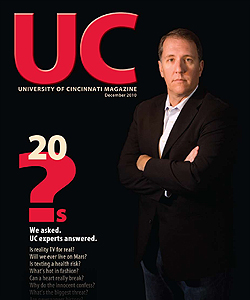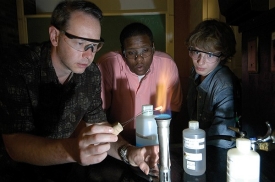Classrooms: How much have they changed?
by Deborah Rieselman
"UC is not your mom and dad's school anymore," says vice provost Gigi Escoe with some pride. "It's a really different place."
For one, students are more diverse than ever before. "The range of students in our classes," Escoe explains, "is pretty intense — from the pre-med student who needs all A's to the person who is happy to just get through, from traditional 19-year-olds who were out late last night to the father of four who has child-care concerns because his wife has the flu.
"There is a certain gift to figuring out how to build structure so that these very diverse students can support each other." The structure, it turns out, is as varied as the student body.
"Faculty now have so many interesting ways to deliver content without lecturing," she says. As a result, undergraduates are conducting research, working in the field, experiencing peer reviews, discussing topics with online study groups and joining Study Abroad programs by videoconferencing with classmates overseas.
Research has shown that "active learning" develops better skills, and today's curriculum looks at "skill-based competencies," Escoe says. "Those are things that we can observe a student doing, then measure whether or not they are able to do them."
Previously, faculty defined courses in terms of content, involving a timeline for learning certain materials. Now faculty and administrators are redesigning all 10,000 courses at UC, determining what students should achieve in each class.
Measuring critical thinking
"Content shouldn't drive our courses," says Pamela Baker, director of UC's Center for Enhancement of Teaching and Learning (CETL), "because knowledge is ever-expanding, and you can't learn everything. If we just try to cram more and more information into our students' heads, they learn less and less.
"We often have these lofty goals — develop critical thinking and writing skills. Well, how would you measure or assess that?"
The center teaches faculty to articulate learning outcomes that they can measure, Baker points out. "That's the big intellectual 180 we have to do. This is where higher education is going right now."
Some faculty have dreaded the laborious task of redesigning every course. Yet enthusiasm has grown among those who have taken seminars related to course redesign, offered at CETL or at Raymond Walters College's Learning and Teaching Center.
"First and foremost, I teach students," says assistant professor Krista Wood, who took one of RWC's yearlong programs. "If I cover physics material, but students do not learn it, then teaching has not occurred. What I value about the course redesign process is that we are building each course from the ground up, not just tweaking what we already do."
Faculty are also changing the way they grade assignments. Baker's students, for instance, may listen to their professor's critique through an audio file. "Typically, we use handwritten comments to justify grades," she says, "but there can be a total disconnect between what I write and what they read."
At RWC, associate professor Robin Lightner's psychology students receive their papers back with a two-page form that evaluates individual components of the assignment, including organization, grammar, terminology, inclusion of scholarly articles and outcomes. "The rubric is important for communicating what we expect from our students," says Lightner, director of the RWC Learning and Teaching Center. "We often want something very specific, but do not explain what we want."
No raising of hands needed
Upon occasion, faculty assess student learning in the middle of a class so they can make immediate adjustments. In the old days, teachers asked students to raise their hands if they didn't understand a point, but embarrassment often superseded honesty.
Today, RWC students can answer an instructor's complicated multiple-choice questions either by clicking on a personal electronic device or by scratching their answers off lottery-type cards. In the latter scenario, students keep selecting and scratching responses until they find the correct one. Afterward, the instructor gathers the cards to determine how many tries it took most of the class to understand the material.
Technological advances, however, are not the panacea for all classes. "What works for me may not work for you," Baker warns. "You have to be selective in your use of technology and intentional about what you do."
Redesigning curriculum for semesters
"Intentional" is a key word in UC's curriculum redesign. Originally, the effort came at the state's indication that all Ohio higher-education calendars should be based on semesters, not quarters, as UC's is. But when Escoe was hired as the university's first vice provost for assessment and student learning in 2008, she jumped at the chance to "rethink everything."
The ambitious endeavor places UC in the position of being "totally cutting-edge," Baker says. "UC has reinvented itself. We are in an incredible transition point."
In the end, changes occur to benefit students, Baker notes. "We care about our students and how we teach them — not just how they will be useful to some employer, but how they will be good citizens of the world. We want to give our students a decent knowledge base and a skill set that makes them adaptable in the 21st century."
"Our students have a right to expect that," Escoe insists.
Link:
Follow semester conversion at UC

 Issue Archive
Issue Archive